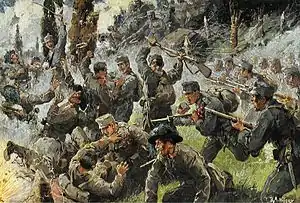Battle of Doberdò
The Battle of Doberdò was fought in August 1916 between the Italian and Austro-Hungarian Armies, composed mostly of Hungarian and Slovenian regiments. The battle, which was part of the Sixth Battle of the Isonzo, took place on a strategic area the westernmost edge of the Karst Plateau. The Italians, who conquered the lowland area around Monfalcone and Ronchi, tried to force themselves over the Karst Plateau in order to gain control over the main road linking the port city of Trieste to the town of Gorizia. After fierce fighting and huge casualties, they succeeded in their attempts. The Austro-Hungarian forces retreated and Gorizia fell to the Italians. They, however, didn't succeed in forcing their way to Trieste, and were stopped northwest of Duino.
| Battle of Doberdò | |||||||
|---|---|---|---|---|---|---|---|
| Part of the Italian Front of the First World War | |||||||
 Depiction of the Battle of Doberdò.[1] | |||||||
| |||||||
| Belligerents | |||||||
|
|
| ||||||
| Commanders and leaders | |||||||
|
|
| ||||||
| Units involved | |||||||
|
|
| ||||||
| Casualties and losses | |||||||
| 6,000 casualties | 9,300 casualties | ||||||
Battle
Before the battle the Austro-Hungarians shifted forces from the Izonzo front to other parts of the war.[2][3] The lack of Austro-Hungarian soldiers at the region resulted in Italian general Luigi Cadorna deciding to attack the river.[2]Fighting started on 6 August,[2] when Italian forces under general Luigi Capello launched an attack on Austro-Hungarian positions guarding the main transport road leading from the coast town of Duino to Gorizia. The main objective of the attack was to secure the transport road, thus securing their advance to Gorizia from the south. A plan was drafted by Italian general Luigi Capello, to split the army in half, with one side attacking straight at Austro-Hungarian positions and the other to attack from the rear. On the morning of 6 August, Austro-Hungarian artillery began shelling Italian infantry as they were drawing nearer. Following the devised plan, four divisions of Italian infantry launched a straight-on frontal assault on Austro-Hungarian trenches, resulting in many soldiers and officers being gunned down by heavy machine-gun fire. With reinforcements, the Italian infantry managed to penetrate through Austro-Hungarian lines, eventually taking the village Doberdò itself. By now, Austro-Hungarian forces were in desperate need for reinforcements to halt the Italian advance towards Gorizia. The other half of the Italian army attacked Austro-Hungarian positions from the rear, as planned. Intensive hand-to-hand fighting commenced, with both sides taking massive losses. Surrounded, Austro-Hungarian forces were forced to retreat, on the line east of Gorizia, giving Italian forces control of the heavily damaged town.
Results
Both sides had taken massive losses, with an estimated of more than 20,000 soldiers killed or missing. Although victorious, Italian losses were high, with around 5,000 of their soldiers killed, due to frontal assaults on superior enemy defenses and the Austro-Hungarians' use of chemical weapons. Italian generals were eager to crush Austro-Hungarian forces in the area, with the intent of going as far as Ljubljana, while Austro-Hungarian generals wanted to preserve their troops (having to fight on two fronts), which gave them fewer men to defend their borders with Italy and also Russia. In all, this was a strategically important victory for the Italians, despite the numerous losses on both sides. The Italian army gained territory around a front that stretched 20 kilomters.[2]
References
- "7/8 The Long Shadow: The Legacies of the Great War in the Twentieth Century, by David Reynolds".
- Carlson, Stephen. "World War I's bloodiest front is one you've never heard of". Business Insider. Retrieved 8 September 2020.
- "Sixth Battle of the Isonzo (6 - 17 August 1916)". Isonzo Battlefields Travel. 7 August 2017. Retrieved 8 September 2020.
- Lukachich, Géza (1918). A Doberdó védelme az első isonzói csatában. [The defense of the Doberdó in the first battle of Isonzó]. Budapest: Atheaneum. p. 89.